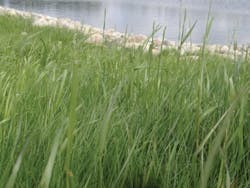About the author: Lauren Alaniz is sales manager for Erosion Control Blankets. Alaniz can be reached at 204.378.2142 or [email protected].
What do rabbits on a small inconspicuous island in the Inland Sea of Japan and construction jobsites have in common? They are all are part of an analogy that provides a different look at vegetation’s nutrient needs. The analogy also will show that it is often the micronutrient needs that have a limiting effect on quantities of vegetation and their long-term viability on jobsites.
Okunoshima is a small island in Japan, once used for the production of poison gas during World War II but now best known for being completely overrun with rabbits—so many rabbits, in fact, that the island is better known as Rabbit Island.
For the sake of the analogy, let’s say you were trapped on Rabbit Island and you had no hope for rescue. The rabbits are plentiful. Many, in fact, will run right up to you. Survival would seem to only entail picking, as many times a day as you like, which is the least cute rabbit to eat. You would never go hungry. You would never have to exert any effort into foraging. But you would never survive long-term.
Even though the rabbits would provide a plentiful food source, you would actually starve to death due to a process known as "rabbit starvation." Rabbit starvation is a condition where a person will sicken and die from subsisting on rabbit as a sole food source. Rabbit is rich in protein, which may seem like a great food source, but it is lacking in fats and vitamins. And it is these less obvious components that are vital for long-term health. So this condition means that huge quantities of food are available, but one would fail to thrive and eventually die because of a lack of nutrients from the plentiful food source.
Making the Connection
How is that similar to jobsites? Our jobsites are often fairly barren, with no nutrition coming into them other than what we provide. Often, our attempts to vegetate those jobsites involve throwing copious amounts of chemical fertilizer at the ground and hoping for the best. We might as well be throwing rabbits at a starving castaway because the effects are the same. Sure, there is as much nitrogen, phosphorus and potassium as the plants could possibly want, just as there is as much protein to be found in the rabbits, but all forms of life—be it plant-based or human—suffer if the other requirements for life are not met. In the case of someone suffering from rabbit starvation, those requirements would be fat and vitamins. In the case of the vegetation we are trying to get established, they are calcium, iron and a host of other micronutrients.
A revegetation plan that is focused exclusively on the macronutrients found in chemical fertilizers ignores all the subsequent research into plant health and nutrient needs that have been discovered in the intervening years. Chemical fertilizers have been around since the mid 1800s, which is surprising, because we tend to consider them as the latest in technological advances.
This is not new technology—it actually can be quite an older and unimproved technology. Interestingly, if we employed other similarly aged Victorian-era technologies today, we would be using bloodletting as a means of trying to cure the common cold or using Daguerreotype plates instead of snapping pictures with our iPhones. Technology and scientific understanding has progressed a lot in the intervening years—we should be employing those advances in the pursuit of better vegetation results on our sites, particularly because there can be serious consequences to improper and/or overuse of chemical fertilizers.
Without considering the balance needed between the heavy doses of macronutrients that chemical fertilizers provide and an emphasis on soil health and the micronutrient needs of the plants, we actually are making our vegetation less resistant to diseases, less drought-tolerant and less resistant to temperature variations.
Biotic soil amendments can provide vital micronutrients to improve and maintain soil health.
Embrace New Technology
It is not the case that chemical fertilizers are not useful in establishing and maintaining vegetation on jobsites. We just cannot depend on them exclusively for the continuing health and sustainability of required vegetation. Soil health is just as important as nutrient loads in establishing and maintaining the vegetation on our sites. Newer advances and research into soil health demonstrate that chemical fertilizers tend to have an acidification effect on soils, which can destroy soil microbial colonies and kill beneficial nematodes and earthworms. Therefore, a balance must be maintained between healthy soil life and its capacity to provide the micronutrients required by plants. This will, in turn, increase the effectiveness of chemical fertilizers while reducing the quantity needed to produce successful vegetation.
On jobsites, we often are restarting soil processes from a degenerated point once projects get to the final stage of revegetation before close-out. To aid in providing the proper balance of sufficient and plentiful soil life that is the source of most of the micronutrients required by plants back to our jobsites, the use of a biotic soil amendment, such as Biotic Earth Black, can be helpful. This type of product would help provide the long-term soil forming and perpetuating processes needed to maintain long-term plant health while reducing the need for chemical fertilizers.
To return to the original analogy when thinking about nutrient needs and the limiting effect on sustaining long-term life, using a biotic soil amendment to improve overall soil health ensures we are feeding our jobsites more than just rabbits.


